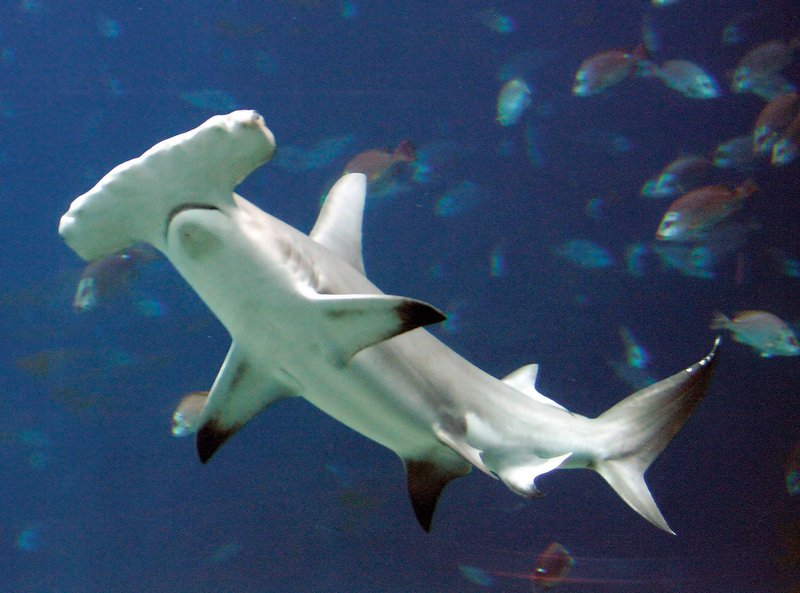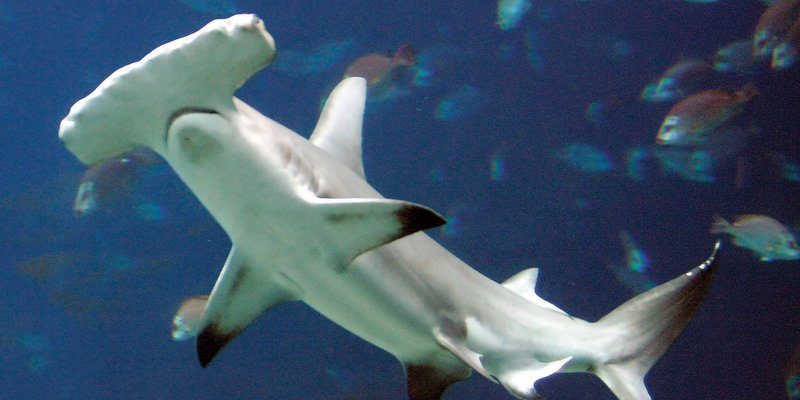
The Hammerhead Shark is one of the ocean’s most fascinating creatures. With its distinctive wide head and incredible swimming abilities, it captures the imagination of both scientists and the general public. Imagine peering into the deep blue sea and spotting this unique shark gliding gracefully through the water. It’s like seeing a stealthy predator that’s also a marvel of nature.
So, what sets the hammerhead apart from other sharks? For starters, its unique head shape isn’t just for show. The hammer-like structure, known as a cephalofoil, enhances its vision and allows it to detect prey with exceptional accuracy. This shark is an excellent example of how evolution shapes animals to thrive in their environments, making them truly remarkable survivors of the ocean.
Physical Characteristics
The physical features of the Hammerhead Shark are what really make it stand out. On average, these sharks can grow between 3 to 20 feet long, depending on the species. The most well-known of the hammerheads is the Great Hammerhead, which can reach lengths of about 20 feet and weigh over 1,000 pounds! Distinctive Features: The wide, flattened head is not just eye-catching; it plays a crucial role in the shark’s hunting strategy.
In terms of coloration, hammerhead sharks typically have a gray or brown back with a white underside, helping them camouflage in their ocean environment. This coloration is vital for both predator and prey interactions. It allows the hammerhead to be stealthy as it approaches potential meals, like fish or cephalopods, making it a successful hunter. Plus, the serrated teeth on its jaw allow it to grip on tightly to slippery prey, ensuring that it doesn’t let go easily.
Beyond their appearance, hammerheads are known for their incredible agility and speed. They can swim swiftly to ambush prey or escape from larger predators, like orcas or larger sharks. With their unique body design, they’re able to turn quickly and navigate through coral reefs. This agility is key to their survival in diverse marine environments.
Habitat and Distribution
Hammerhead sharks are commonly found in warm waters, typically in tropical and subtropical regions around the globe. They prefer areas close to coastline waters, including bays and shallow waters, as well as offshore areas. You might find them cruising through coral reefs or hunting in deeper waters, showcasing their adaptability to various marine environments.
One interesting aspect of their behavior is that hammerheads are often seen in schools, particularly during the day. These groups can consist of dozens or even hundreds of individuals. Swimming in numbers can provide safety in numbers, reducing the chances of becoming prey to larger predators. This social structure is intriguing and highlights the complex behaviors of these sharks.
As they grow older, hammerheads tend to become more solitary. Adult hammerheads usually hunt alone or in smaller groups, relying on their exceptional hunting abilities to catch prey. This shift in social behavior illustrates how their needs change as they develop, and it’s a fascinating area of study for marine biologists.
Diet and Hunting Behavior
The diet of hammerhead sharks is quite diverse, consisting primarily of fish, squid, and crustaceans. Their unique head shape allows them to have a wider field of vision, which comes in handy when hunting. It’s like having a built-in radar system that detects prey from different angles. These sharks tend to hunt during the day, using their keen eyesight to spot meals.
One of the most interesting hunting techniques is their method of *”cooperative hunting.”* They often work together in schools to herd fish into tight balls, making it easier for them to capture their meals. This teamwork is fascinating and shows a level of intelligence and strategy in their hunting behavior that many people might not expect from sharks.
Hammerheads are also known to use a unique technique called “head-butting.” They may use their broad heads to stun prey, making it easier to catch fish or squid. This method showcases the adaptability and intelligence of hammerhead sharks, demonstrating that even predators have creative approaches to hunting.
Reproduction and Lifespan
Hammerhead sharks have a unique reproductive strategy known as viviparity, which means that they give birth to live young rather than laying eggs. Female hammerheads usually have a gestation period ranging from 9 to 12 months, depending on the species. Once ready to give birth, a female can have anywhere from 20 to 50 pups in a single litter, which is quite an impressive number considering their size.
When the pups are born, they are fully formed and can swim away immediately, which is essential for their survival. This strategy helps reduce the chances of them being eaten by predators, including their own parents. For younger hammerheads, survival rates can be tough, but as they mature, their chances of making it in the wild improve greatly.
The lifespan of hammerhead sharks varies by species, but many can live between 20 to 30 years. Some individuals have been known to live even longer in the right conditions. Their longevity is a testament to their adaptability and the successful strategies they employ in the vast and often challenging environment of the ocean.
Conservation Status
Despite their fascinating characteristics, hammerhead sharks face several threats, primarily due to human activities. Overfishing has significantly impacted their populations. Hammerheads are often targeted for their fins, which are in high demand for shark fin soup, a delicacy in some cultures. This practice not only threatens their survival but also disrupts the delicate balance of marine ecosystems.
In addition to overfishing, habitat loss due to coastal development and pollution poses significant risks to hammerhead populations. As their natural environments shrink, their chances of survival diminish. Conservation efforts are crucial to ensuring these magnificent sharks continue to thrive in their natural habitats.
Many organizations are working to protect hammerhead sharks through education, research, and advocacy. Measures such as enforcing fishing quotas, establishing protected marine areas, and promoting sustainable fishing practices are essential for their conservation. Community involvement and raising awareness about the importance of sharks in the ecosystem play a vital role in their protection.
Interesting Facts
| Species | Great Hammerhead, Scalloped Hammerhead, Smooth Hammerhead |
| Size | 3 to 20 feet |
| Weight | Up to 1,000 pounds |
| Habitat | Tropical and subtropical waters |
| Diet | Fish, squid, crustaceans |
| Lifespan | 20 to 30 years |
FAQ
What do hammerhead sharks eat?
Hammerhead sharks primarily consume fish, squid, and crustaceans. Their diet can vary based on the species and the available prey in their habitat. They are known to hunt during the day and often use teamwork to herd fish into tight balls, making it easier to catch them. This cooperative behavior is a fascinating aspect of their hunting strategies.
Why do hammerhead sharks have a unique head shape?
The distinctive hammer-shaped head, known as the cephalofoil, serves several important functions. It provides a wider field of vision, enhances sensory perception, and allows for better maneuverability in the water. This shape helps them detect electrical signals produced by prey, making them effective hunters.
Are hammerhead sharks dangerous to humans?
While hammerhead sharks are powerful predators, they are generally not considered a significant threat to humans. Most species of hammerheads are known to be shy and avoid contact with people. However, like all wild animals, they should be respected and observed from a distance, as their behavior can be unpredictable.
How fast can a hammerhead shark swim?
Hammerhead sharks are capable of impressive speeds, reaching up to 20 miles per hour when swimming. Their agility and speed help them chase down prey and evade larger predators, showcasing their adaptations for survival in the ocean.
How long do hammerhead sharks live?
The lifespan of hammerhead sharks varies by species, but most can live between 20 to 30 years. Some individuals may even live longer, depending on environmental conditions and threats they face. Understanding their lifespan helps researchers gauge population dynamics and conservation needs.
How do hammerhead sharks reproduce?
Hammerhead sharks reproduce via a method called viviparity, which means that they give birth to live young instead of laying eggs. Females have a gestation period of approximately 9 to 12 months and can give birth to 20 to 50 pups at a time. This reproductive strategy increases the chances of survival for the young sharks.
What are some threats to hammerhead sharks?
Hammerhead sharks face significant threats from overfishing, habitat loss, and pollution. They are often targeted for their fins due to the demand for shark fin soup. Protecting these sharks requires concerted efforts from conservation organizations, communities, and regulations to ensure sustainable practices in marine environments.
Can hammerhead sharks swim in cold water?
Hammerhead sharks prefer warmer waters and are typically found in tropical and subtropical regions. While they may occasionally venture into cooler waters, they tend to thrive in temperatures ranging from 68 to 80 degrees Fahrenheit. Cold water is not their preferred habitat due to potential impacts on their metabolism and hunting efficiency.
What role do hammerhead sharks play in the ecosystem?
Hammerhead sharks play a vital role in maintaining the balance of marine ecosystems. As predators, they help regulate fish populations, ensuring healthy ocean dynamics. Their presence indicates a robust marine environment, making their conservation crucial for the overall health of oceanic ecosystems.

